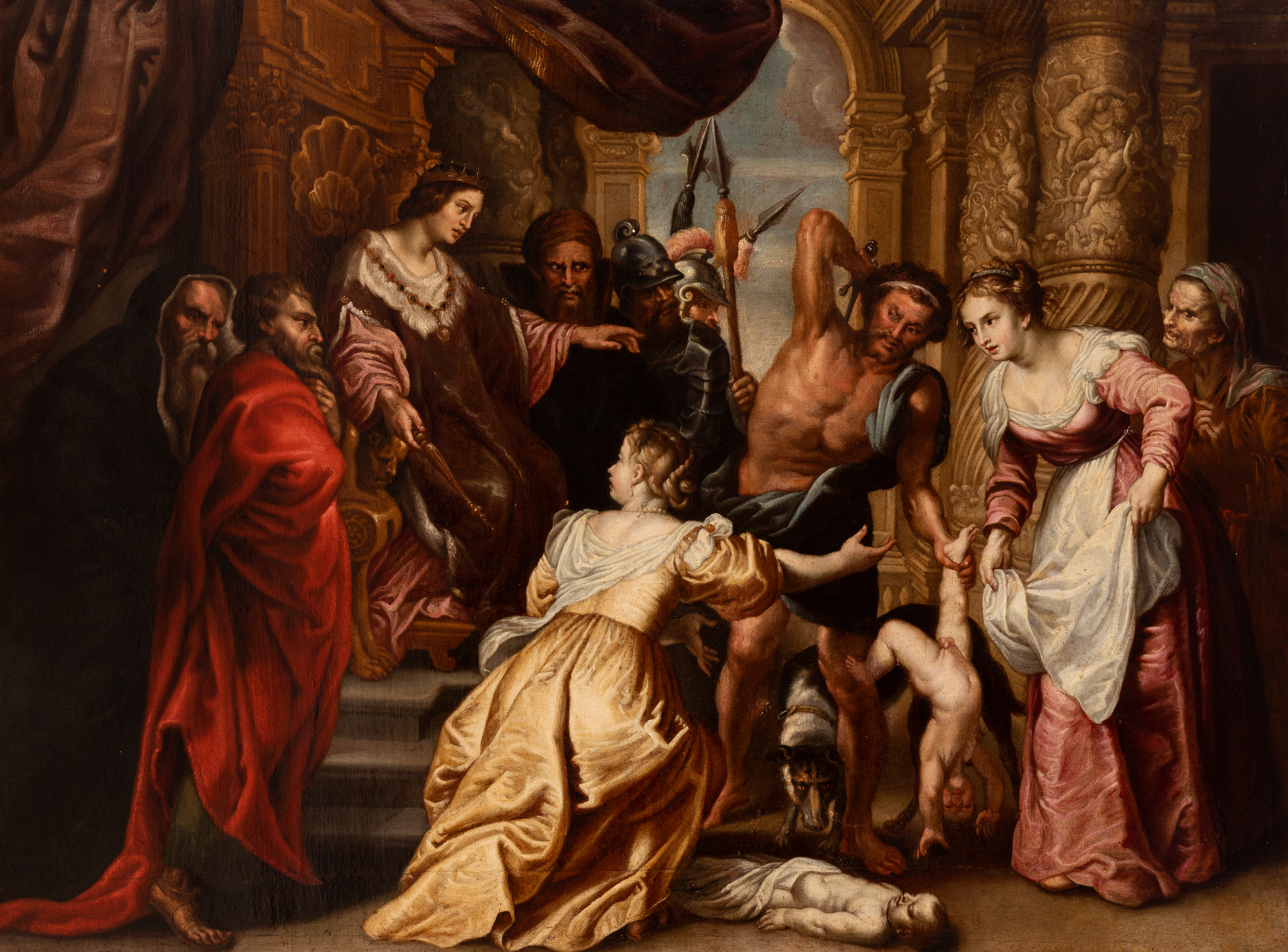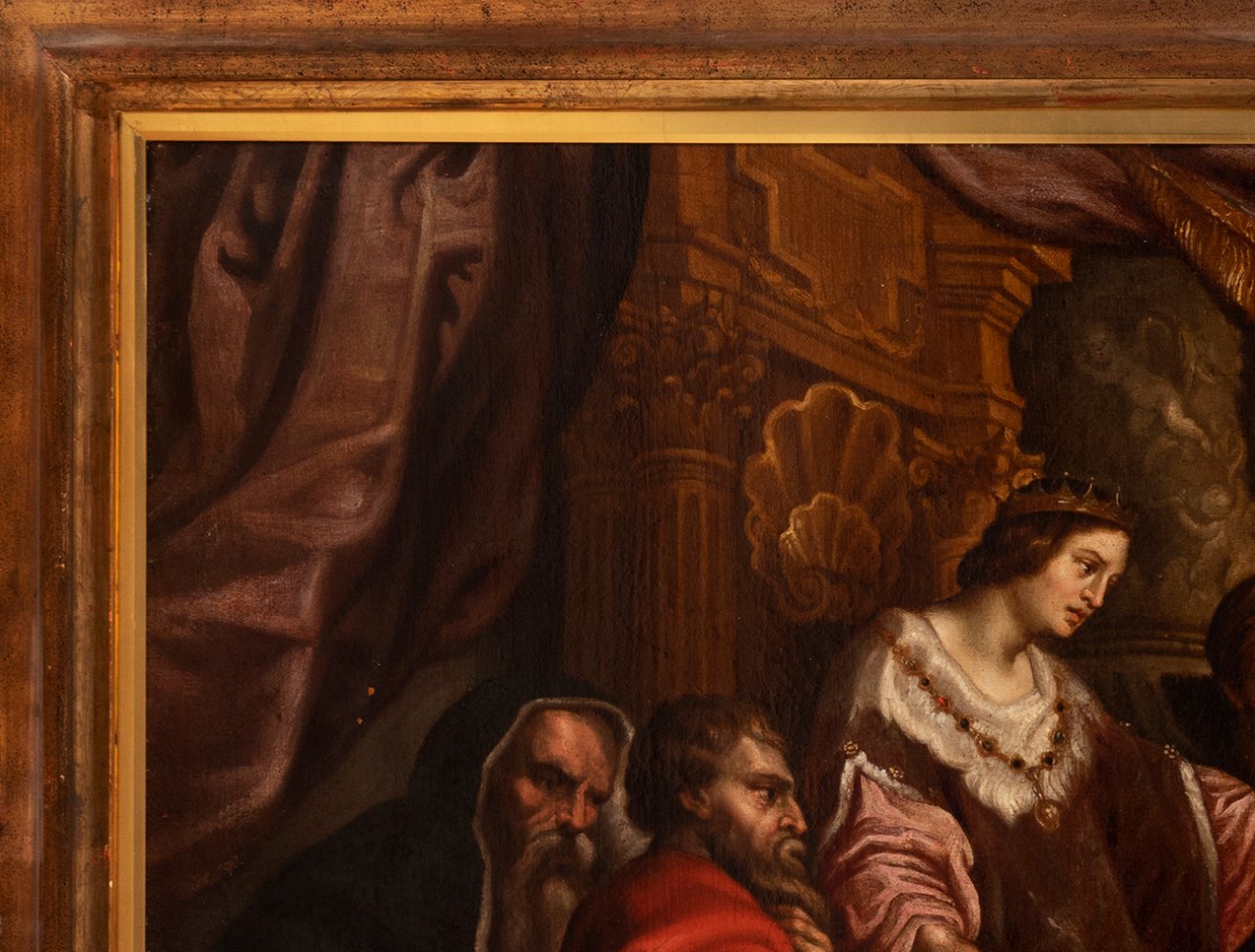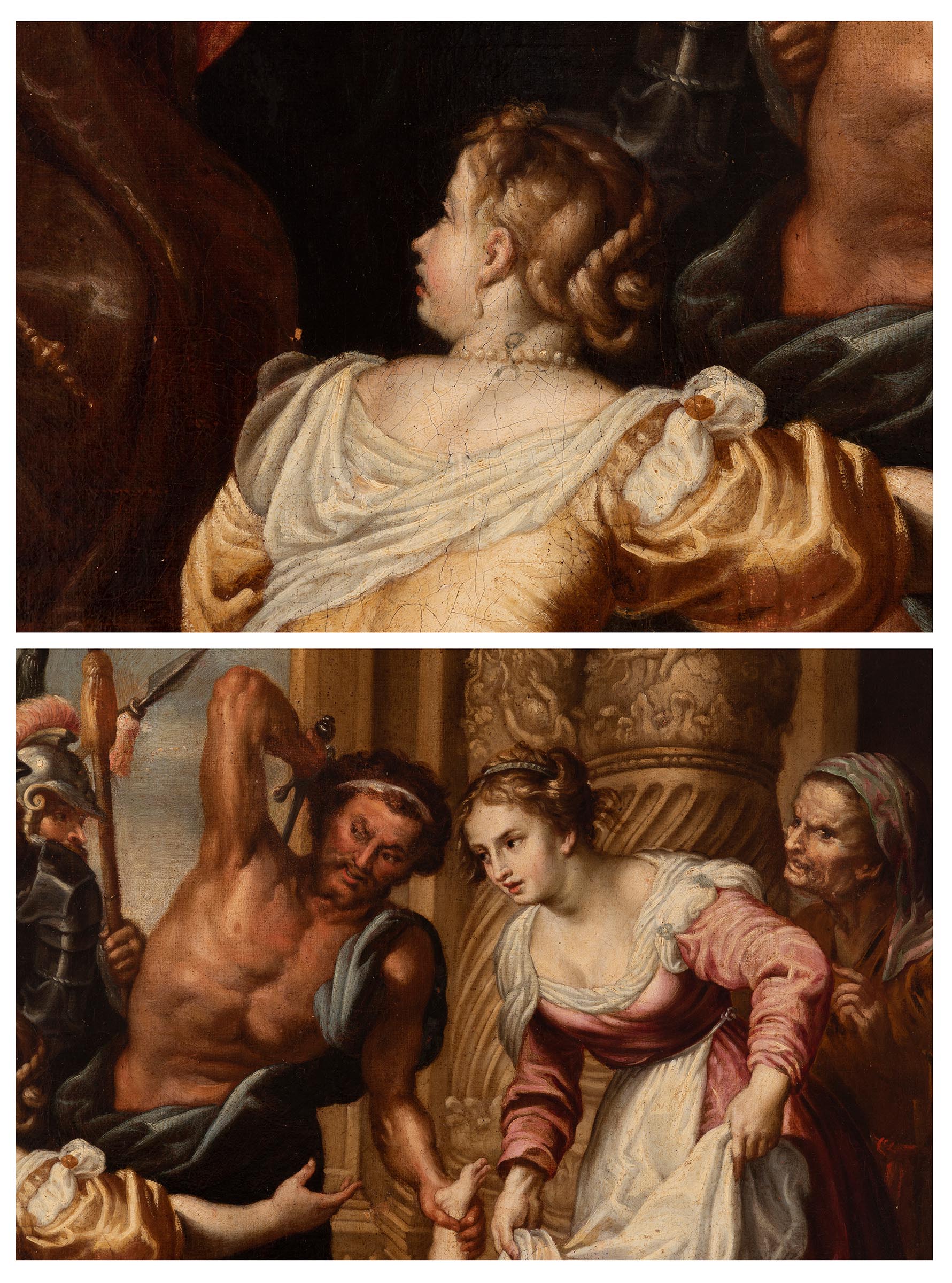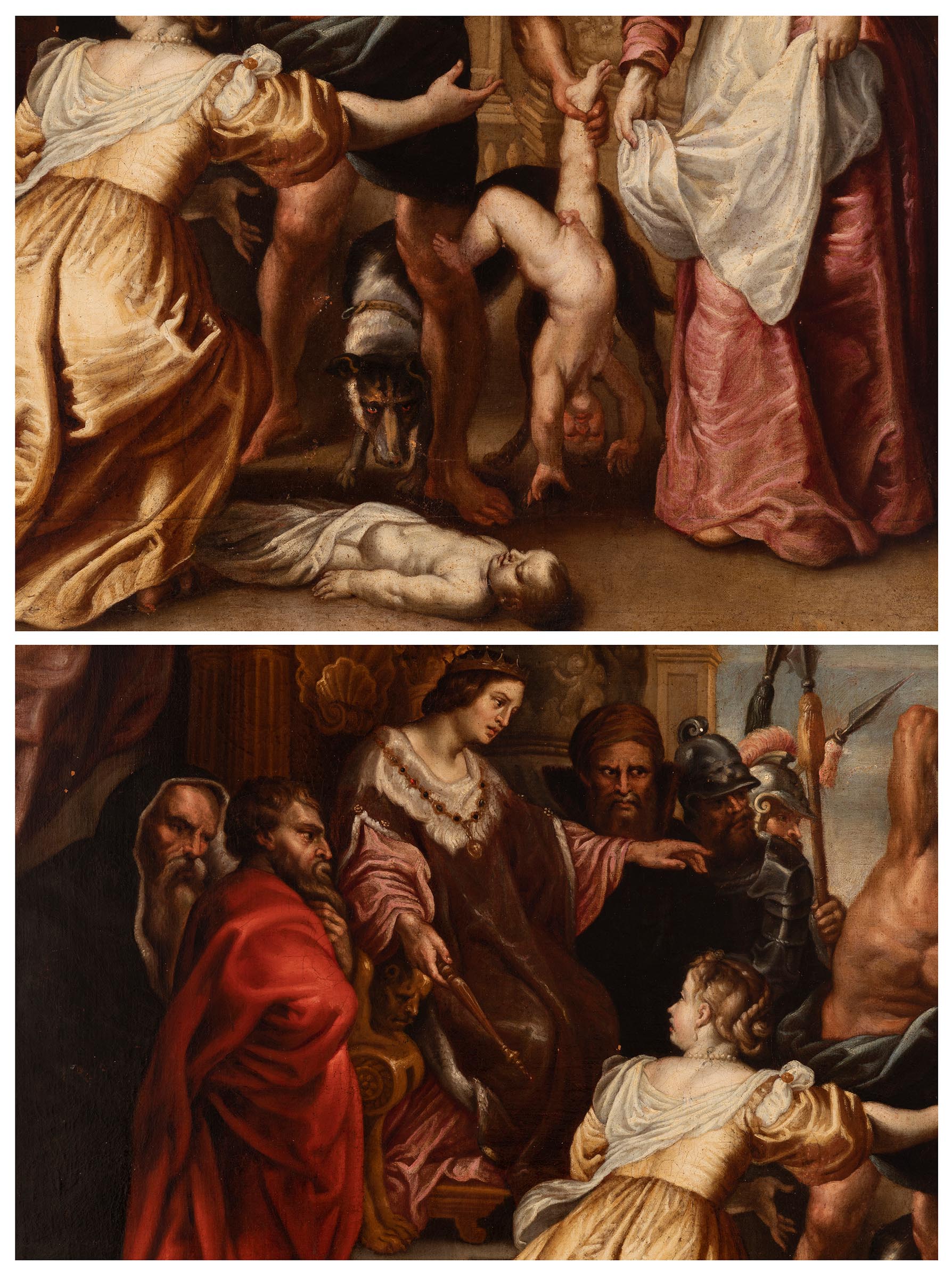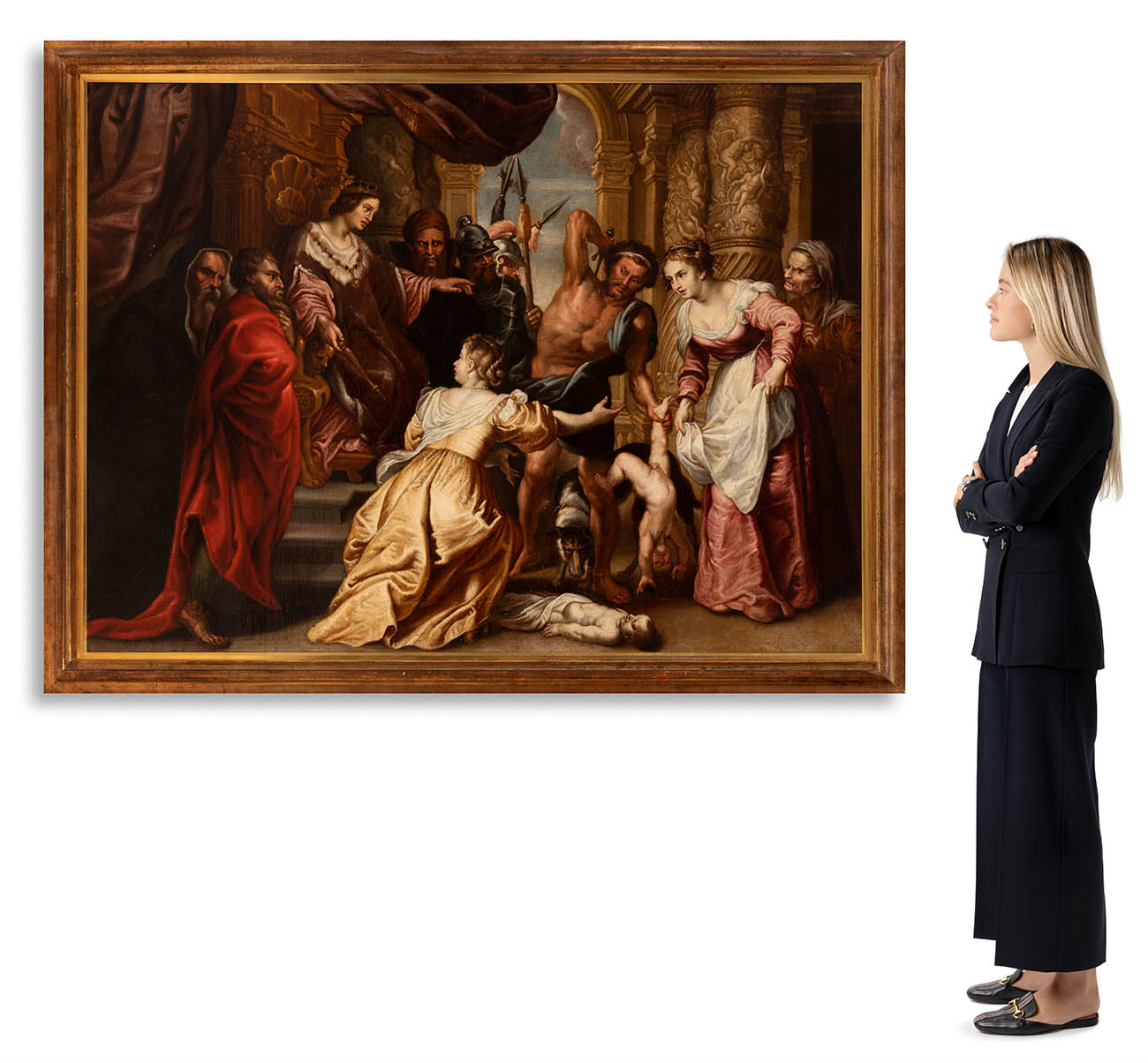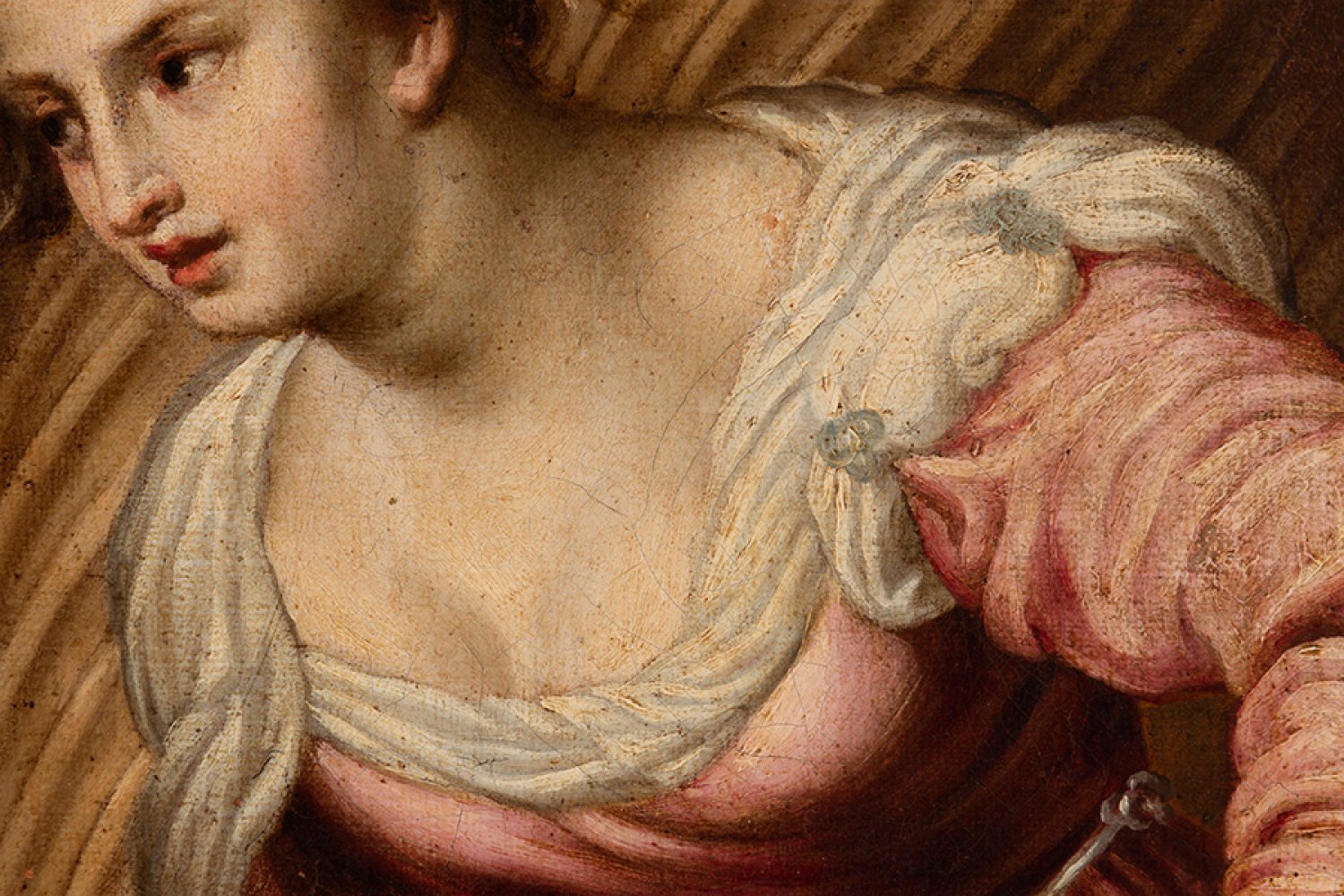9
Spanish school; mid-17th century."The Judgement of Solomon".Oil on canvas. Re-framed.Size: 121 x 164
"The Judgement of Solomon".
Oil on canvas. Re-framed.
Size: 121 x 164 cm; 177 x 135 cm (frame).
In this work the painter narrates the scene of the trial of Solomon with great attention to detail, composing a scene of great narrative and scenographic character, located in an interior slightly open to landscape and populated by numerous characters. The composition of the scene is notable for its dynamism and movement, which comes from the dramatic postures adopted by some of the figures, such as the mothers on the right and the male figure holding a child. The foreshortening of these figures, including the baby who follows the wine, generates both the aforementioned dynamism and a greater sense of spatiality. Although there are certain differences, it is worth noting the compositional and thematic similarity of the present work to the painting by Rubens in the Museo del Prado collection, which was documented in 1746 as part of the collection of Isabella of Farnese. With regard to the subject matter of the work, it should be noted that the Judgement of Solomon is narrated in the Old Testament (I Kings 3:16-28), and describes the wise recourse used by the king of Israel to ascertain the truth of the case before him: the dispute between two women, the son of one of whom had died, both of whom claimed to be the mother of the living child. The episode exalts the justice and wisdom of the one who wields legitimate political power, that is, the one that comes from God according to the traditional interpretation. It also highlights the value of maternal abnegation, which prefers to renounce one's own right for the sake of the child, in contrast to the evil of envy, which prefers the evil of others even if it is not to one's own advantage. This scene has been depicted in art since the Middle Ages, and its iconography influenced the composition of different themes with similar elements: the life decision of a magistrate, usually enthroned, accompanied by soldiers and generally with the presence of a female figure.
As already mentioned, due to the formal characteristics of the work, this painting can be related to the circle of Peter Paul Rubens, a painter of the Flemish school who nevertheless competed on equal terms with contemporary Italian artists and was of major international importance, given that his influence was also key in other schools, as in the case of the transition to the full Baroque in Spain. Although born in Westphalia, Rubens grew up in Antwerp, where his family originated. After completing his training Rubens joined the Antwerp painters' guild in 1598. Only two years later he travelled to Italy, where he stayed from 1600 to 1608. During this decisive period, the young Flemish master had first-hand experience of naturalism and classicism, the works of Caravaggio and the Carracci.
"The Judgement of Solomon".
Oil on canvas. Re-framed.
Size: 121 x 164 cm; 177 x 135 cm (frame).
In this work the painter narrates the scene of the trial of Solomon with great attention to detail, composing a scene of great narrative and scenographic character, located in an interior slightly open to landscape and populated by numerous characters. The composition of the scene is notable for its dynamism and movement, which comes from the dramatic postures adopted by some of the figures, such as the mothers on the right and the male figure holding a child. The foreshortening of these figures, including the baby who follows the wine, generates both the aforementioned dynamism and a greater sense of spatiality. Although there are certain differences, it is worth noting the compositional and thematic similarity of the present work to the painting by Rubens in the Museo del Prado collection, which was documented in 1746 as part of the collection of Isabella of Farnese. With regard to the subject matter of the work, it should be noted that the Judgement of Solomon is narrated in the Old Testament (I Kings 3:16-28), and describes the wise recourse used by the king of Israel to ascertain the truth of the case before him: the dispute between two women, the son of one of whom had died, both of whom claimed to be the mother of the living child. The episode exalts the justice and wisdom of the one who wields legitimate political power, that is, the one that comes from God according to the traditional interpretation. It also highlights the value of maternal abnegation, which prefers to renounce one's own right for the sake of the child, in contrast to the evil of envy, which prefers the evil of others even if it is not to one's own advantage. This scene has been depicted in art since the Middle Ages, and its iconography influenced the composition of different themes with similar elements: the life decision of a magistrate, usually enthroned, accompanied by soldiers and generally with the presence of a female figure.
As already mentioned, due to the formal characteristics of the work, this painting can be related to the circle of Peter Paul Rubens, a painter of the Flemish school who nevertheless competed on equal terms with contemporary Italian artists and was of major international importance, given that his influence was also key in other schools, as in the case of the transition to the full Baroque in Spain. Although born in Westphalia, Rubens grew up in Antwerp, where his family originated. After completing his training Rubens joined the Antwerp painters' guild in 1598. Only two years later he travelled to Italy, where he stayed from 1600 to 1608. During this decisive period, the young Flemish master had first-hand experience of naturalism and classicism, the works of Caravaggio and the Carracci.
9th November - Old Masters
Sale Date(s)
Venue Address
General delivery information available from the auctioneer
Setdart offers Worldwide shipping
PICK UP IN ROOM: You can come and pick up your lots in our offices (Barcelona, Madrid or Valencia). At the moment of the withdrawal, you will be able to accept the current conditions of the lot by means of a document that you will sign.
YOU CAN SEND ANOTHER PERSON TO PICK UP: This person must present a signed authorization that you can find in our web page by accessing from BUY AT SETDART- LOGISTICS-DOWNLOAD AUTHORIZATION DOCUMENT. You can also send an e-mail with the requested data in AUTHORIZATION DOCUMENT to admin@setdart.com
Important Information
25% buyer´s premium
OR
21% buyer´s premium at www.setdart.com
Terms & Conditions
The maximum period to pay the lots is 7 working days. You can pay either via bank transfer or with credit card through our platform www.setdart.com (we only accept VISA or Mastercard).
BUYER´S PREMIUM: 22% Hammer price + 21% VAT from the buyer´s premium
If your piece has more than 100 years, our Ministry of Culture requires an export certificate in order for the piece to leave the country. Note that if the piece goes inside the EU, there is no cost for the export certificate. If the piece goes outside the EU, there is a cost for the export certificate. You can find more information in our Ministry of Culture website: https://www.culturaydeporte.gob.es/en/cultura/patrimonio/exportacionimportacion/exportacion/tasas.html
INQUIRIES: admin@setdart.com
Setdart guides you through the entire process, from the time of award to the day you receive your lot. Our logistics team will be happy to manage your transport, and will advise you on the best shipping method with professionals from the sector used to handling works of art and jewelry.
WE OFFER WORLDWIDE DOOR TO DOOR SHIPPING
PICK UP IN ROOM: You can come and pick up your lots in our offices. At the moment of the withdrawal, you will be able to accept the current conditions of the lot by means of a document that you will sign.
YOU CAN SEND ANOTHER PERSON TO PICK UP: This person must present a signed authorization that you can find in our web page by accessing from BUY AT SETDART-LOGISTICS-DOWNLOAD AUTHORIZATION DOCUMENT. You can also send an e-mail with the requested data in AUTHORIZATION DOCUMENT to admin@setdart.com
SETDART IS NOT RESPONSIBLE FOR THE STATE OF THE PARTS ONCE THEY LEAVE OUR FACILITIES. MRW SHIPMENTS: Once the payment is made, your lot will be packed for shipment, the logistics department will send you an e-mail notifying you of the day it leaves our warehouse, changes of address cannot be made after receiving this e-mail.
INSURANCE INCIDENTS: Coverage for the value of the auction up to 3000 ? per shipment, if the value of the auction is higher, Setdart will send you a quote including the additional insurance. The insurance company WILL NOT BE RESPONSIBLE FOR THE SHIPMENT THAT EXCEEDS THAT AMOUNT AND IS NOT FULLY INSURED. MRW INCIDENTS: Maximum notification 48 hours after receipt, after which the insurance company WILL NOT BE RESPONSIBLE AND NO CLAIMS WILL BE ACCEPTED.
E-MAIL LOGISTICS: logistica@setdart.com
PICK UP YOUR MESSAGES: You can send your own messaging, prior notice via e-mail that your shipment is ready, please note 3 or 4 days in advance. This type of shipment is packaged so Setdart will provide you with a quote.
EXPENSES FOR STORAGE: We inform you that if the purchased lot is not picked up within a month, you will be charged 30€ per week per lot. Setdart Online S.L., owner of the web site "setdart.com", "setdart.net" and "setdart.org", acts as a company of Spanish nationality inscribed in the Volume 36955, sheet 182, page B-293056 of the Mercantile Registry, with registered office at Calle Aragó













